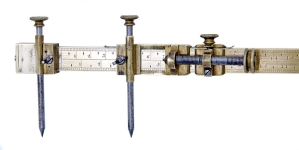Scientific Instrument Society 25th Anniversary Exhibition
Navigation:
<< First | < Previous | Next > | Last >>
04 Sisson's Beam Compass by Adams
The beam compass was used for the setting off or transferring of precise measurements, for graduating scales or for drawing curves of large radius. For portability, the rule is in two halves that can be clipped together. It is just under two feet long and has two scales with inches divided into thirty and forty equal parts.
Writing in 1791, George Adams Jnr (1750-1795) describes this instrument as ‘Sisson’s protracting scale’. It is not clear whether the instrument maker Jonathan Sisson (c.1690-1747) or his son Jeremiah (c.1720-1783) is referred to.
Six years later William Jones, who had bought the rights to Adams’s book, described the instrument in more detail. The scales have been divided into three and four chains in an inch and each of these subdivided into ten links which, with the vernier, can be set to single links. When surveying with a Gunter’s chain the measurement can be directly set on the beam compass for accurately transferring to a plan. The surveying chain, invented by Edmund Gunter (1581-1626), consisted of 100 links and was 66 feet long.
This particular example was made between 1757 and 1760 by George Adams senior.
The signature is on the reverse: ‘Made by Geo. Adams Instrument Maker to His Royal Highness GEORGE Prince of Wales London’. The engraved letters arefilled with the original red wax.
The dating is established by noting that King George III (1738-1820) became Prince of Wales in 1750 and King in 1760. He came of maturity in the middle of 1756 and was thus able to run his own household and make appointments. George Adams Snr. (1709-1772) was appointed as Instrument Maker to the Prince late in 1756.
See: John R. Millburn, Adams of Fleet Street, Instrument Makers to King George III, Aldershot 2000. (Published with support from the Scientific Instrument Society).
George Adams, Geometrical and Graphical Essays, London 1791
Private Collection, West Midlands, U.K.
P.D.
Objects lent by Anonymous Lender II, West Midlands, UK:
13. Waywiser, by George Adams jr, London, between 1784 and 1796
35. Silver Engine-Turned Box Sextant, by Troughton, London, c. 1810
37. Sextant, by Jesse Ramsden, London, c.1765
42. Hydrostatic Balance, by George Adams, London, c. 1760
50. Three Early Forms of Electro-Magnetic Demonstration Motor, English, c. 1835-40



